First Sokoban program
From Sokoban Wiki
(→First Sokoban program) |
m (→Play the game: Updated link to the Internet Archive.) |
||
| (36 intermediate revisions not shown) | |||
| Line 1: | Line 1: | ||
| - | + | The [https://en.wikipedia.org/wiki/Sokoban Sokoban] game was invented in 1981 by Hiroyuki Imabayashi, Japan, and was first published by his software company, ''Thinking Rabbit'', in December 1982 for the [https://en.wikipedia.org/wiki/PC-8800_series NEC PC-8801] computer. The game was distributed as cassette tape media. | |
| - | + | ||
| - | + | ||
| - | The | + | |
| - | + | ||
| - | + | ||
| - | + | ||
| - | The game was distributed as cassette tape media. | + | |
= Start of the game = | = Start of the game = | ||
| Line 18: | Line 11: | ||
You have started a part-time job in a large warehouse company. | You have started a part-time job in a large warehouse company. | ||
| - | Your job is to | + | Your job is to clear up 20 warehouse buildings. |
You must organize the boxes in the buildings. | You must organize the boxes in the buildings. | ||
| - | + | Because the boxes are large, you can only push them one at a time. | |
| - | If you do a bad job the boxes will get | + | If you do a bad job the boxes will get stuck. |
Hence, you have to be careful. | Hence, you have to be careful. | ||
| Line 32: | Line 25: | ||
3 Key (Right) | 3 Key (Right) | ||
| - | The boxes | + | The boxes must be placed on the red dots. |
| - | + | Press the F1 key when the job is done, or if you want to start over again. | |
| - | Press the | + | Press the Space key to start! |
</pre> | </pre> | ||
| - | |||
= Program features = | = Program features = | ||
| - | The game | + | The game offers 20 levels to be played. |
| - | + | ||
| - | + | ||
| - | + | ||
| - | + | ||
| - | + | ||
After a level has been solved it's necessary to press F1. | After a level has been solved it's necessary to press F1. | ||
| - | This | + | This makes the program check whether the level has been solved, in which case the player can proceed to the next level. |
| - | + | If F1 is pressed when the level hasn't been solved, the player is given the choice between exiting the game and restarting the level. | |
| - | The player has 5 attempts to solve the level, | + | The player has 5 attempts to solve the level, meaning it's possible to restart a level 4 times. |
| + | This first version of the program erroneously makes the dots representing the goal squares disappear when the player walks over them. | ||
= Levels = | = Levels = | ||
| - | The first 10 levels are | + | The first 10 levels are regular Sokoban levels. |
| + | |||
| + | Levels 11 to 20 contain some destructible walls. | ||
| + | |||
| + | These special walls look the same as the other not destructible walls. | ||
| - | |||
| - | |||
However, the player can walk over these walls from specific sides and thereby destroy the walls. | However, the player can walk over these walls from specific sides and thereby destroy the walls. | ||
| Line 72: | Line 62: | ||
The levels first become solvable after destroying these special walls. | The levels first become solvable after destroying these special walls. | ||
| - | Later versions of Sokoban don't contain | + | The walls can only be destroyed when entering them from one specific side. |
| + | However, in level 20 there is one exception. <br> | ||
| + | Level 20 contains a destructible wall at the top right which can be entered from left and right: <br> | ||
| + | [[image:First Sokoban Level 20 special wall.png]] | ||
| + | |||
| + | <br> | ||
| + | Later versions of Sokoban don't contain this special destructible wall type anymore. | ||
| + | |||
| + | = Source code = | ||
The source code of this first Sokoban game was printed in the 1987 book "THE 倉庫番", pages 117-122. | The source code of this first Sokoban game was printed in the 1987 book "THE 倉庫番", pages 117-122. | ||
| + | |||
| + | The program was written in BASIC. | ||
| + | |||
| + | = Game solved = | ||
| + | |||
| + | After the last level has been solved (and F1 has been pressed so the game checks if the level is solved) the game prints "Congratulation": | ||
| + | [[image:First Sokoban Game solved.png]] | ||
| + | |||
| + | = Game texts = | ||
| + | |||
| + | [Level failed]<br> | ||
| + | Do your best or you’ll get fired!<br> | ||
| + | Try again?(Y/N) | ||
| + | |||
| + | |||
| + | [Level complete]<br> | ||
| + | The first warehouse is done!<br> | ||
| + | Go to the next warehouse?(Y/N) | ||
| + | |||
| + | |||
| + | [Game over]<br> | ||
| + | You’re now dismissed!<br> | ||
| + | Start over?(Y/N) | ||
| + | |||
| + | |||
| + | [All levels complete]<br> | ||
| + | The message is ”ウサギ(rabbit)” | ||
| + | |||
| + | = Interview with Hiroyuki Imabayashi = | ||
| + | |||
| + | You can read a 1983 interview with Hiroyuki Imabayashi on [https://shmuplations.com/thinkingrabbit/ shmuplations.com/thinkingrabbit]. | ||
| + | |||
| + | Carlos Montiers Aguilera published his interesting 2020 Internet conversation about Sokoban with Hiroyuki Imabayashi at: [https://sokoboxes.com/articles/my-conversation-with-mr-hiroyuki www.sokoboxes.com]. | ||
| + | |||
| + | = Play the game = | ||
| + | |||
| + | Using a so-called emulator, the original program can run on newer computer systems. Here is a package that lets you install and play the original program on computers with the Microsoft Windows operating system: | ||
| + | |||
| + | [https://archive.org/details/sokoban-1982_20240412 Sokoban 1982 - The First Sokoban Program]. | ||
| + | |||
| + | The package contains two versions of the program: | ||
| + | * 1982 - The original 1982 Sokoban program. | ||
| + | * 2022 - A bugfixed and enhanced version of the 1982 Sokoban program. | ||
Current revision as of 06:01, 12 April 2024
The Sokoban game was invented in 1981 by Hiroyuki Imabayashi, Japan, and was first published by his software company, Thinking Rabbit, in December 1982 for the NEC PC-8801 computer. The game was distributed as cassette tape media.
Contents |
Start of the game
Screenshot of the entry screen of the game:
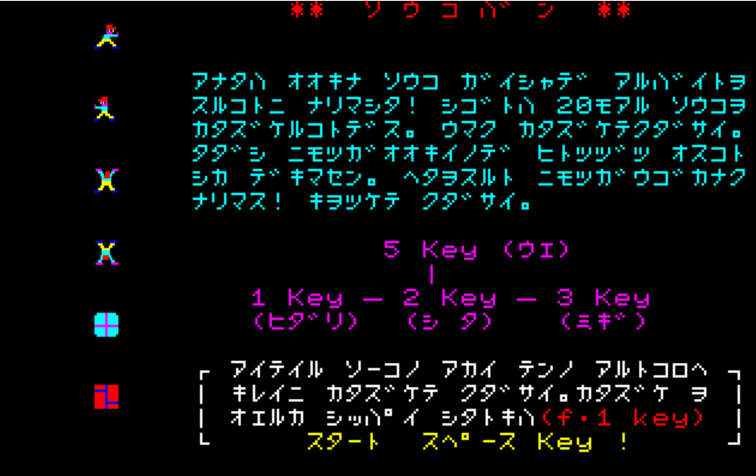
** Sokoban ** You have started a part-time job in a large warehouse company. Your job is to clear up 20 warehouse buildings. You must organize the boxes in the buildings. Because the boxes are large, you can only push them one at a time. If you do a bad job the boxes will get stuck. Hence, you have to be careful. 5 Key (Up) 1 Key (Left) 2 Key (Down) 3 Key (Right) The boxes must be placed on the red dots. Press the F1 key when the job is done, or if you want to start over again. Press the Space key to start!
Program features
The game offers 20 levels to be played.
After a level has been solved it's necessary to press F1. This makes the program check whether the level has been solved, in which case the player can proceed to the next level.
If F1 is pressed when the level hasn't been solved, the player is given the choice between exiting the game and restarting the level.
The player has 5 attempts to solve the level, meaning it's possible to restart a level 4 times.
This first version of the program erroneously makes the dots representing the goal squares disappear when the player walks over them.
Levels
The first 10 levels are regular Sokoban levels.
Levels 11 to 20 contain some destructible walls.
These special walls look the same as the other not destructible walls.
However, the player can walk over these walls from specific sides and thereby destroy the walls.
This is level 15 in the original game:
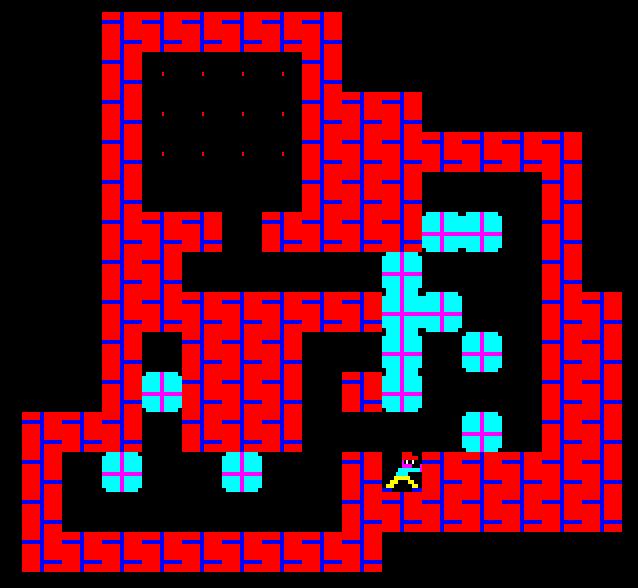
This is the same level having the destroyable walls highlighted in blue and the direction they can be walked over indicated by small arrows:
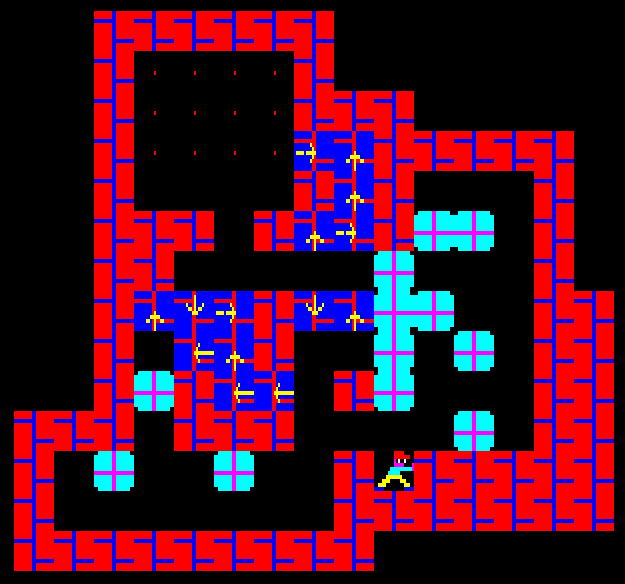
The levels first become solvable after destroying these special walls.
The walls can only be destroyed when entering them from one specific side.
However, in level 20 there is one exception.
Level 20 contains a destructible wall at the top right which can be entered from left and right:
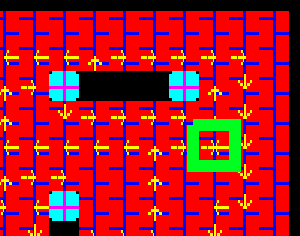
Later versions of Sokoban don't contain this special destructible wall type anymore.
Source code
The source code of this first Sokoban game was printed in the 1987 book "THE 倉庫番", pages 117-122.
The program was written in BASIC.
Game solved
After the last level has been solved (and F1 has been pressed so the game checks if the level is solved) the game prints "Congratulation":
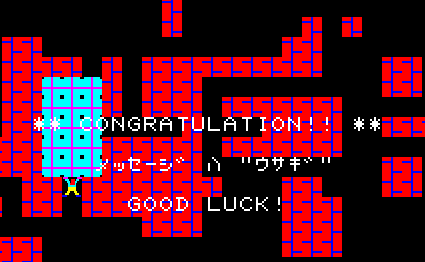
Game texts
[Level failed]
Do your best or you’ll get fired!
Try again?(Y/N)
[Level complete]
The first warehouse is done!
Go to the next warehouse?(Y/N)
[Game over]
You’re now dismissed!
Start over?(Y/N)
[All levels complete]
The message is ”ウサギ(rabbit)”
Interview with Hiroyuki Imabayashi
You can read a 1983 interview with Hiroyuki Imabayashi on shmuplations.com/thinkingrabbit.
Carlos Montiers Aguilera published his interesting 2020 Internet conversation about Sokoban with Hiroyuki Imabayashi at: www.sokoboxes.com.
Play the game
Using a so-called emulator, the original program can run on newer computer systems. Here is a package that lets you install and play the original program on computers with the Microsoft Windows operating system:
Sokoban 1982 - The First Sokoban Program.
The package contains two versions of the program:
- 1982 - The original 1982 Sokoban program.
- 2022 - A bugfixed and enhanced version of the 1982 Sokoban program.
